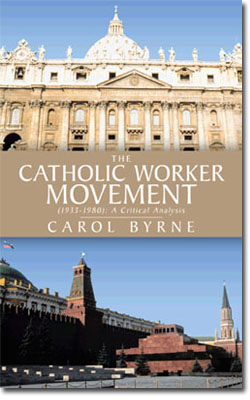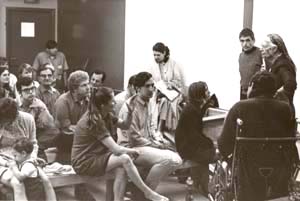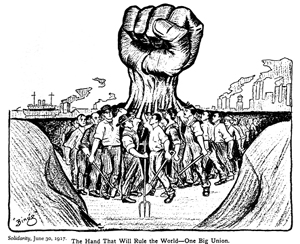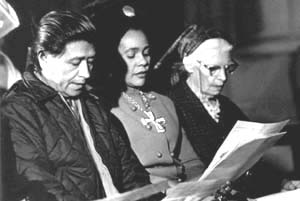Cardinal Timothy Dolan Promotes Marxist for Sainthood
Pope’s Possible Successor Promotes Marxist for Sainthood
American Catholic Cardinal Timothy Dolan, reported to be in the running to replace Pope Benedict XVI as the head of the Roman Catholic Church, is usually described as a “conservative” because he has strongly criticized President Obama’s attacks on religious liberty and federal intrusions into church affairs. But Dolan is also the leader of the campaign to promote Marxist Dorothy Day for Sainthood.
In a letter obtained by this journalist, Virginia State Senator Richard H. “Dick” Black was so disgusted by the push for sainthood for Dorothy Day that he told the Pope on January 7, 2013, that he was “appalled” that “a woman of such loathsome character” would be considered for sainthood.
Black, a retired Marine Corps colonel, noted that “Vatican archives are filled with reports of Christians martyred under the regimes that Dorothy Day supported.
I am revolted by the United States Conference of Catholic Bishops’ support for the canonization of a woman whose views supported the violent extermination of Christians throughout the world. I ask that these matters be carefully weighed so that the Holy See will not be inadvertently misled when considering the canonization of Dorothy Day.”
Nevertheless, The New York Times reported, “Cardinal Dolan has embraced her cause with striking zeal: speaking on the anniversaries of her birth and death, distributing Dorothy Day prayer cards to parishes and even buying roughly 100 copies of her biography to give out last year as Christmas gifts to civic officials including Mayor Michael R. Bloomberg.”
Link
Tags:
Views: 386
Replies to This Discussion
-
Permalink Reply by Cathleen on February 13, 2013 at 8:46am
-
May God have mercy on us all, and forgive us.
-
Permalink Reply by Dawn Marie on February 13, 2013 at 12:54pm
-
I'm really lost here. I thought Dorothy Day was a leader in the Marxist movement. But in this Rome Reports ironically enough (as the article of Card. Dolan surfaces at the same time) the Pope says she is a convert. What?
Does anyone have any information on this woman to substantiate that she converted? This is news to me.
February 13, 2013. (Romereports) “I thank you all for the love and prayers that have accompanied me. Thank you," said the Pope. "In these difficult days, I've felt almost physically, the power of prayer that comes through the love for the Church and your personal prayers. Continue to pray for me, for the Church and the future Pope. The Lord will guide.”
Looking calm and serene, Benedict XVI led his first public appearance, after announcing his resignation. Before a full crowd, he once again said he made the decision with complete liberty. He echoed Monday's statement by saying that he does not have the strength to carry out the office.
Then he continued with his weekly catechesis, on Ash Wednesday.He talked about the temptation Jesus experienced when He was in the desert. In today's modern world, said the Pope, the temptation is to push faith aside and seek false solutions.BENEDICT XVI
“While the Lord continues to raise up examples of radical conversion, like Pavel Florensky, Etty Hillesum and Dorothy Day, he also constantly challenges those who have been raised in the faith to deeper conversion.”During this Lenten season, the Pope invited people to open their minds and hearts, as Christ knocks on their door. A source of true inspiration, he says, is that Jesus himself overcame temptation out in the desert.The Vatican's Paul VI Hall was full of pilgrims who greeted the Pope, interrupting him with applause throughout, to show their gratitude for the last eight years.
-
Permalink Reply by Michael on February 13, 2013 at 3:22pm
-
This article is from Tradition in Action and helps to outline that Dorothy Day did convert to Catholicism, but did not abandon her socialist positions.
Book reviews







The Catholic Worker Movement:
A Critical Analysis
Dr. Carol ByrneI believe that no one is better qualified than the author of a book to present an objective synopsis of it. With this in mind, I asked Dr. Byrne, a British expert on the Catholic Worker Movement and Distributism, to introduce TIA readers to her recently published book The Catholic Worker Movement (1933-1980): A Critical Analysis (Bloomington: AuthorHouse, 2010, 332 pp.). She kindly agreed, and here is the summary she offers us. The Editor 
Purchase this book here or hereEver since Dorothy Day and Peter Maurin founded the Catholic Worker Movement (CWM) in 1933, the subject of its being a Communist front has become the elephant in the room – something of which CWM aficionados are inwardly aware but which they all agree to outwardly ignore. They have succeeded in circulating the myth, implicitly believed even by members of the clergy who should know better, that Day left Communism behind when she entered the Catholic Church.
So when Cardinal John O’Connor of New York wrote to the Congregation for the Causes of Saints in February 2000 requesting that Dorothy Day’s Cause be introduced, he alleged that after she became a Catholic Dorothy Day was never a member of any “political groups hostile to the Church, for example, Communists, Socialists or anarchists,” and that “she did not approve of their tactics or any denial of private property.”
From this, we must infer that the Cardinal has been not only misled but is misleading others as authentic documentary evidence exists to prove the falseness of these claims. As far as I know, my book is the first and only study, based on archival sources not previously available to the public, which shows that Dorothy Day, after her conversion to Catholicism, did in fact become a member of several Socialist organizations and was actively involved in political groups whose founders and leaders were predominantly members of the Communist Party of the USA (CPUSA).
The book provides details of how Day shared public platforms with high profile Communists including Elizabeth Gurley Flynn, a paid official of the CPUSA (and later its first woman Chairman), took an active part in an array of Communist-led strikes during the 1930s and ‘40s and used her newspaper, the Catholic Worker (CW), of which she was editor for almost 50 years, as an organ of propaganda in favor of Communism. All this must be considered against the background of the decree issued by the Holy Office in 1949 pronouncing an anathema on any Catholic who cooperated with Communists in any way. The fact that she was able to flout the papal ban against Communist-aiding Catholics merely conferred on her an added mystique among her supporters.
While declaring herself committed to a non-violent revolution, Day nonetheless supported every Socialist regime around the world regardless of its violent beginnings and inhumane consequences. There is documentary evidence that Day supported the policies of hostile foreign powers operating from Moscow, Havana, Peking and Hanoi against her own country, the USA.
Dorothy Day and Marxist Fr. Daniel Berrigan, standing at right, orient hippies for anti-war protestsShe also wrote favorably about such Socialist dictators as Lenin, Castro, Mao and Ho Chi Minh, even though they had all violently persecuted the Church in their respective countries. Is it not ironic that some Catholics who died in Communist purges of the 20th century have been canonized while the Vatican is considering sainthood for a Catholic who spent most of her life collaborating with their executioners?
The book demonstrates how Day arrived at her position on absolute Pacifism simply by relying on her personal opinions and identifying them with the teachings of Christ. Here it is important to keep in mind that we are dealing with a private interpretation of the Gospels, and that the Church has never taught that the sayings of Jesus establish a case for Pacifism. The problem is that Day made her private opinions into a universal claim that all war is wrong, but the fact remains that war is not, in all cases, prohibited by the Christian law.
When Cardinal O’Connor stated that Dorothy Day’s commitment to Pacifism distinguished her from Communists, he did not seem to be aware of the Kremlin-controlled Peace Movement of the 1960s or the extent to which Day’s Pacifist stance actually helped further Communist objectives, particularly during the Vietnam War era. With regard to the situation in the United States, the function of Pacifism, as evidenced in its effect, was to debilitate the national will, to demoralize opposition to Socialist States, to inhibit US defenses against Communist aggression and thus to imperil the national interest.
There is more to Day’s Pacifism than meets the eye. Her involvement in the Peace Movement needs to be considered against the wider background of the radical activism of anti-war groups with which she cooperated – all of them founded, infiltrated and funded by Communist-supporting officials who sat on each others’ committees, shared platforms, contributed to each other’s publications and shared a common desire to destroy the political and economic structures of Western societies. We must conclude that her Pacifism, apart from being treasonable to her own country, was intellectually dishonest insofar as she knowingly served the interests of Socialism while pretending to be also serving the interests of Christianity.
International Communist - similar to Day's positionDespite her constant bleating about non-violence, violence is a built-in feature of her revolutionary position. A close examination of the works of those who influenced Day and Maurin – from the Russian anarchist Kropotkin to the French ideologue Emmanuel Mounier to the Liberation Theology practitioners of Latin America – shows that they have all advocated violence as a necessary, even indispensable, tool in the cause of the anti-capitalist revolution.
However, there is no validation in Catholic tradition for Day’s positions on Anarchism, Pacifism, Personalism, “Christian Communism”, unionism, civil disobedience, Liberation Theology or her idea that the Mystical Body of Christ encompasses the whole of mankind. She simply twisted the teachings of the Scriptures, the Saints, the Church Fathers and the papal encyclicals to arrive at her preconceived conclusions.
For those who think that Day loved the Church, my book exposes the ugly, unvarnished details of her anti-clericalism. The most striking characteristic of Day’s criticism of the Catholic Church was its similarity to the material found in Soviet anti-religious posters and periodicals. Her words echoed the standard Socialist propaganda blaming the clergy for being too rich, for allying themselves with powerful governments and for oppressing the working people.
It was not simply a question of fraternal correction of certain pastors whose behavior may have fallen short of the evangelical spirit and caused scandal to the faithful – she was remarkably tolerant of errant clergy who were on her side – it was a denunciation of the clergy as representatives of the “ruling class,” the class of the “oppressors.”
The Red Left: Cesar Chavez, Coretta King & Dorothy DayThis brings us to the unkindest cut of all – Day’s insistence that it was the Church’s wealth that caused the persecutions it suffered throughout History, when the catalyst in many of such persecutions was the attempt by Socialists to poison the public mind against the clergy and expropriate their property. Such an approach to Christianity is favorable neither to procuring justice in the world, to genuine freedom nor to the interests of the Catholic Church of which she was a member.
The book also explores the CWM’s commitment to ecumenism, religious liberty, liberation theology, worker priests and liturgical experimentation that it had been promoting for decades before Vatican II. It shows how these phenomena contributed to the long process of moral dissolution culminating in the 1960s that helped to normalize anarchy and dissent within the Church and promiscuity, homosexuality and radical feminism among the American public.
Both Day’s and Maurin’s goal was a Communist society that would abolish the system of wage-labor and free enterprise and produce a classless society characterized by shared ownership of goods and communal child rearing. Day even published an article that called “for some union in which the individual States will agree to surrender national sovereignty in favor of a world society.” (Catholic Worker, June 1955) Their whole aim was to keep the Communist dream alive and introduce it into the Church through Christian-Marxist dialogue.
Day’s supporters are still ignoring the elephant in the room. It’s a very large elephant and hard to squeeze around. Are we being disorientated because of that elephant? If so, isn’t it time to adjust our visual field and see it for what it is?Dr. Carol Byrne may be contacted here
© 2025 Created by Dawn Marie.
Powered by
![]()